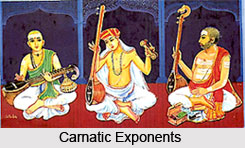 Genres of Carnatic Music are mainly of three types. These include varnam, kriti and ragam-tanam-pallavi. Varnam is kalpita sangita, composed music. Through varnam, the tripartite structure (pallavi-anupallavi-charanam) was introduced. Along with this there was the inclusion of solfege passages within that form, and the srotovaha principle of melodic and rhythmic development. Kriti is the major kalpita sangita genre in the tradition of Classical Carnatic Music. It can be a combination of both kalpita sangita and manodharma sangita (improvised music), because it can include kalpana svara and niraval. If kriti is preceded by even a brief alapanam, then the progression from un-metered to metered is present. Otherwise, both varnam and kriti are entirely metered. Within the kriti are found existing the possibilities for flexibility and expansion of the formal structure. Basic principles herein are the prominence of the tala, since it is tied so closely to the text throughout, and the ever present contrasts in speed through mathematical proportions.
Genres of Carnatic Music are mainly of three types. These include varnam, kriti and ragam-tanam-pallavi. Varnam is kalpita sangita, composed music. Through varnam, the tripartite structure (pallavi-anupallavi-charanam) was introduced. Along with this there was the inclusion of solfege passages within that form, and the srotovaha principle of melodic and rhythmic development. Kriti is the major kalpita sangita genre in the tradition of Classical Carnatic Music. It can be a combination of both kalpita sangita and manodharma sangita (improvised music), because it can include kalpana svara and niraval. If kriti is preceded by even a brief alapanam, then the progression from un-metered to metered is present. Otherwise, both varnam and kriti are entirely metered. Within the kriti are found existing the possibilities for flexibility and expansion of the formal structure. Basic principles herein are the prominence of the tala, since it is tied so closely to the text throughout, and the ever present contrasts in speed through mathematical proportions.
The most outstanding genre of Carnatic Classical Music is the Ragam-tanam-pallavi, composed entirely in manodharma sangita, with the exception of the short pallavi composition. Improvisation is the crux of this style. It is a challenge taken up by the best musicians, and to be a pallavi vidvan is to be a `musician`s musician.` The progression from unmetered to metered, and from free raaga to the emphasis on rhythm in general and complex rhythmic manipulation in particular, are in full play here, and all members of a performing ensemble must prove their musical mettle.
Another organizational principle present here is the ragamalika, which may appear in various genres. In one varnam or kriti, each section is in a different raaga. In groups of varnam, kriti, or tanam, each composition in a chain is in a different raaga. Ragamalika can also be utilized in pallavi improvisation if a performer so desires. Also possible, though not frequently done, is the talamalika, a garland of talas, operating on the same principle as ragamalika.
Although Carnatic classical music has a much larger repertoire of composed pieces than Hindustani classical music, and although composed pieces take a much larger share of Carnatic concert time, the underlying principle of both traditions is the same: basic structures within which there are a host of possibilities for making music. These structures, and also the whole gamut of possibilities that they encompass, contribute to distinguishing one genre from another in both the Carnatic and Hindustani traditions.